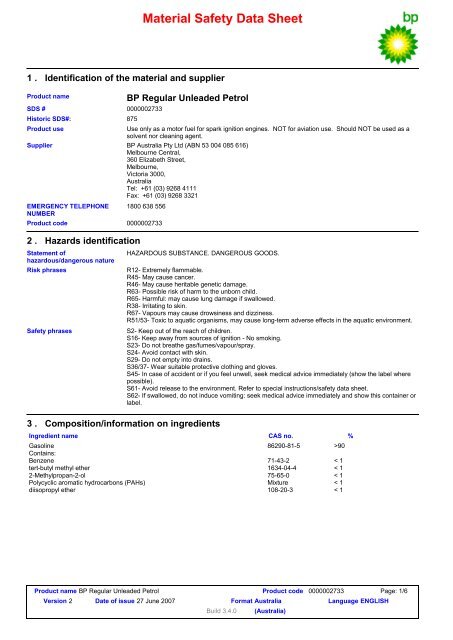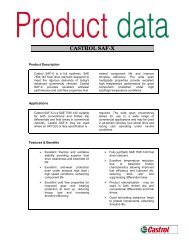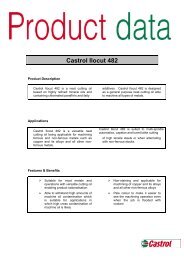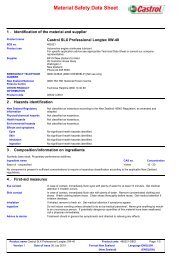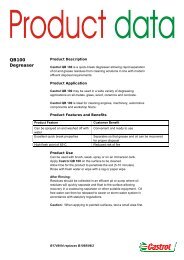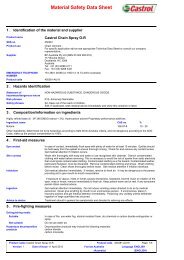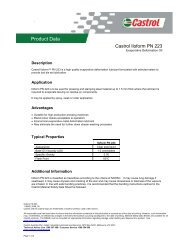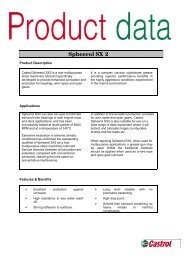BP Unleaded Petrol - Lawnmowing Contractors Association
BP Unleaded Petrol - Lawnmowing Contractors Association
BP Unleaded Petrol - Lawnmowing Contractors Association
You also want an ePaper? Increase the reach of your titles
YUMPU automatically turns print PDFs into web optimized ePapers that Google loves.
Material Safety Data Sheet<br />
1 . Identification of the material and supplier<br />
Product name<br />
SDS #<br />
Historic SDS#:<br />
Product use<br />
Supplier<br />
EMERGENCY TELEPHONE<br />
NUMBER<br />
<strong>BP</strong> Regular <strong>Unleaded</strong> <strong>Petrol</strong><br />
0000002733<br />
875<br />
Use only as a motor fuel for spark ignition engines. NOT for aviation use. Should NOT be used as a<br />
solvent nor cleaning agent.<br />
<strong>BP</strong> Australia Pty Ltd (ABN 53 004 085 616)<br />
Melbourne Central,<br />
360 Elizabeth Street,<br />
Melbourne,<br />
Victoria 3000,<br />
Australia<br />
Tel: +61 (03) 9268 4111<br />
Fax: +61 (03) 9268 3321<br />
1800 638 556<br />
Product code 0000002733<br />
2 .<br />
Hazards identification<br />
Statement of<br />
hazardous/dangerous nature<br />
Risk phrases<br />
Safety phrases<br />
3 .<br />
HAZARDOUS SUBSTANCE. DANGEROUS GOODS.<br />
R12- Extremely flammable.<br />
R45- May cause cancer.<br />
R46- May cause heritable genetic damage.<br />
R63- Possible risk of harm to the unborn child.<br />
R65- Harmful: may cause lung damage if swallowed.<br />
R38- Irritating to skin.<br />
R67- Vapours may cause drowsiness and dizziness.<br />
R51/53- Toxic to aquatic organisms, may cause long-term adverse effects in the aquatic environment.<br />
S2- Keep out of the reach of children.<br />
S16- Keep away from sources of ignition - No smoking.<br />
S23- Do not breathe gas/fumes/vapour/spray.<br />
S24- Avoid contact with skin.<br />
S29- Do not empty into drains.<br />
S36/37- Wear suitable protective clothing and gloves.<br />
S45- In case of accident or if you feel unwell, seek medical advice immediately (show the label where<br />
possible).<br />
S61- Avoid release to the environment. Refer to special instructions/safety data sheet.<br />
S62- If swallowed, do not induce vomiting: seek medical advice immediately and show this container or<br />
label.<br />
Composition/information on ingredients<br />
Ingredient name<br />
CAS no.<br />
Gasoline 86290-81-5 >90<br />
Contains:<br />
Benzene 71-43-2 < 1<br />
tert-butyl methyl ether 1634-04-4 < 1<br />
2-Methylpropan-2-ol 75-65-0 < 1<br />
Polycyclic aromatic hydrocarbons (PAHs) Mixture < 1<br />
diisopropyl ether 108-20-3 < 1<br />
%<br />
Product name <strong>BP</strong> Regular <strong>Unleaded</strong> <strong>Petrol</strong><br />
Product code 0000002733<br />
Page: 1/6<br />
Version 2 Date of issue 27 June 2007<br />
Format Australia<br />
Language ENGLISH<br />
Build 3.4.0 (Australia)
4 .<br />
First-aid measures<br />
Eye contact<br />
Skin contact<br />
Inhalation<br />
Ingestion<br />
In case of contact, immediately flush eyes with a copious amount of water for at least 15 minutes. Get<br />
medical attention if irritation occurs.<br />
In case of contact, immediately flush skin with plenty of water. Remove contaminated clothing and<br />
shoes. Wash clothing before reuse. Clean shoes thoroughly before reuse. Get medical attention if<br />
irritation develops.<br />
If exposure to vapour, mists or fumes causes drowsiness, headache, blurred vision or irritation of the<br />
eyes, nose or throat, remove immediately to fresh air. Keep patient warm and at rest. If any symptoms<br />
persist obtain medical advice.<br />
Unconscious casualties must be placed in the recovery position. Monitor breathing and pulse rate and<br />
if breathing has failed, or is deemed inadequate, respiration must be assisted, preferably by the mouth<br />
to mouth method. Administer external cardiac massage if necessary. Seek medical attention<br />
immediately. Seek immediate medical attention.<br />
If swallowed, do NOT induce vomiting. Never give anything by mouth to an unconscious person.<br />
Aspiration hazard if swallowed- can enter lungs and cause damage. Obtain medical attention<br />
immediately.<br />
5 .<br />
Fire-fighting measures<br />
Extinguishing Media<br />
Suitable<br />
Hazards from combustion<br />
products<br />
Unusual fire/explosion<br />
Hazards<br />
Special fire-fighting<br />
procedures<br />
Protection of fire-fighters<br />
In case of fire, use water fog, foam, dry chemical or carbon dioxide extinguisher or spray.<br />
These products are carbon oxides (CO, CO2) (carbon monoxide, carbon dioxide)<br />
Extremely flammable liquid and vapour. Vapour may cause flash fire. Vapours may accumulate in low<br />
or confined areas, travel a considerable distance to a source of ignition and flash back. Runoff to sewer<br />
may create fire or explosion hazard.<br />
DO NOT FIGHT FIRE WHEN IT REACHES MATERIAL. Withdraw from fire and let it burn. Promptly<br />
isolate the scene by removing all persons from the vicinity of the incident if there is a fire. First move<br />
people out of line-of-sight of the scene and away from windows.<br />
Fire-fighters should wear self-contained positive pressure breathing apparatus (SCBA) and full turnout<br />
gear.<br />
6 . Accidental release measures<br />
Emergency Procedures<br />
Methods and materials for<br />
containment and clean-up<br />
Immediately contact emergency personnel. Eliminate all ignition sources. Keep unnecessary<br />
personnel away. Use suitable protective equipment (See Section: "Exposure controls/personal<br />
protection"). Follow all fire fighting procedures (See Section: "Fire-fighting measures"). Do not touch<br />
or walk through spilled material.<br />
If emergency personnel are unavailable, contain spilled material. For small spills add absorbent (soil<br />
may be used in the absence of other suitable materials) scoop up material and place in a sealed, liquidproof<br />
container for disposal. For large spills dike spilled material or otherwise contain material to<br />
ensure runoff does not reach a waterway. Place spilled material in an appropriate container for<br />
disposal. Avoid contact of spilt material with soil and prevent runoff entering surface waterways. See<br />
Section 13 for Waste Disposal Information.<br />
7 .<br />
Handling and storage<br />
Handling<br />
Storage<br />
Aspiration hazard if swallowed- can enter lungs and cause damage. Do not ingest. If ingested do not<br />
induce vomiting. Avoid prolonged or repeated contact with skin. Use only with adequate ventilation.<br />
Do not breathe vapour or mist. Keep away from heat, sparks and flame. To avoid fire or explosion,<br />
dissipate static electricity during transfer by earthing and bonding containers and equipment before<br />
transferring material. Use explosion-proof electrical (ventilating, lighting and material handling)<br />
equipment. Avoid contact of spilled material and runoff with soil and surface waterways. Wash<br />
thoroughly after handling.<br />
Store in a segregated and approved area. Keep container in a cool, well-ventilated area. Keep<br />
container tightly closed and sealed until ready for use. Avoid all possible sources of ignition (spark or<br />
flame). Store and use only in equipment/containers designed for use with this product. Do not remove<br />
warning labels from containers.<br />
Do not enter storage tanks without breathing apparatus unless the tank has been well ventilated and<br />
the tank atmosphere has been shown to contain hydrocarbon vapour concentrations of less than 1% of<br />
the lower flammability limit and an oxygen concentration of at least 20% volume.<br />
Light hydrocarbon vapours can build up in the headspace of tanks. These can cause<br />
flammability/explosion hazards even at temperatures below the normal flash point (note: flash point<br />
must not be regarded as a reliable indicator of the potential flammability of vapour in tank headspaces).<br />
Tank headspaces should always be regarded as potentially flammable and care should be taken to<br />
avoid static electrical discharge and all ignition sources during filling, ullaging and sampling from<br />
storage tanks.<br />
Product name <strong>BP</strong> Regular <strong>Unleaded</strong> <strong>Petrol</strong><br />
Product code 0000002733<br />
Page: 2/6<br />
Version 2 Date of issue 27 June 2007<br />
Format Australia<br />
Language ENGLISH<br />
Build 3.4.0 (Australia)
When the product is pumped (e.g. during filling, discharge or ullaging) and when sampling, there is a<br />
risk of static discharge. Ensure equipment used is properly earthed or bonded to the tank structure.<br />
If product comes into contact with hot surfaces, or leaks occur from pressurised fuel pipes, the vapour<br />
or mists generated will create a flammability or explosion hazard.<br />
Product contaminated rags, paper or material used to absorb spillages, represent a fire hazard, and<br />
should not be allowed to accumulate. Dispose of safely immediately after use.<br />
Additional information-<br />
Storage<br />
This product must be handled in compliance with Australian Standard: The storage and handling of<br />
flammable and combustible liquids [Standard 1940-2004 as amended and adapted].<br />
8 . Exposure controls/personal protection<br />
Ingredient name<br />
Occupational exposure limits<br />
Benzene NOHSC (Australia, 8/2005).<br />
TWA: 3.2 mg/m 3 8 hour(s).<br />
TWA: 1 ppm 8 hour(s).<br />
tert-butyl methyl ether NOHSC (Australia, 8/2005).<br />
STEL: 275 mg/m 3 15 minute(s).<br />
STEL: 75 ppm 15 minute(s).<br />
TWA: 92 mg/m 3 8 hour(s).<br />
TWA: 25 ppm 8 hour(s).<br />
2-Methylpropan-2-ol NOHSC (Australia, 1995).<br />
STEL: 455 mg/m 3 15 minute(s).<br />
STEL: 150 ppm 15 minute(s).<br />
TWA: 303 mg/m 3 8 hour(s).<br />
TWA: 100 ppm 8 hour(s).<br />
Polycyclic aromatic hydrocarbons (PAHs)<br />
NOHSC (Australia).<br />
TWA: 0.2 mg/m 3 8 hour(s).<br />
diisopropyl ether NOHSC (Australia, 8/2005).<br />
STEL: 1300 mg/m 3 15 minute(s).<br />
STEL: 310 ppm 15 minute(s).<br />
TWA: 1040 mg/m 3 8 hour(s).<br />
TWA: 250 ppm 8 hour(s).<br />
Gasoline ACGIH TLV (United States, 5/2004).<br />
STEL: 1480 mg/m 3 15 minute(s). Form: All forms<br />
STEL: 500 ppm 15 minute(s). Form: All forms<br />
TWA: 890 mg/m 3 8 hour(s). Form: All forms<br />
TWA: 300 ppm 8 hour(s). Form: All forms<br />
Where there are no regulatory exposure limits, for information and guidance, the ACGIH values are included.<br />
For further information on these please consult your supplier.<br />
Whilst specific OELs for certain components are included in this SDS, it should be noted that other components of the preparation will be<br />
present in any mist, vapour or dust produced. For this reason, the specific OELs may not be applicable to the product and are provided for<br />
guidance purposes.<br />
Biological Limit Values<br />
Control Measures<br />
No biological limit allocated.<br />
Provide exhaust ventilation or other engineering controls to keep the relevant airborne concentrations<br />
below their respective occupational exposure limits.<br />
Ensure that eyewash station and safety shower is proximal to the workstation location. All chemicals<br />
should be assessed for their risks to health and appropriate control measures put in place to prevent or<br />
adequately control exposure. A hierarchy of control measures exists (e.g. elimination, substitution,<br />
general ventilation, containment, systems of work, changing the process or activity) that must be<br />
considered before use of personal protective equipment. Personal protective equipment should<br />
conform to appropriate standards, be suitable for use, be kept in good condition and properly<br />
maintained.<br />
Your supplier of personal protective equipment should be consulted for advice on selection and<br />
appropriate standards. For further information contact your national organisation for standards.<br />
The final choice of protective equipment will depend upon a risk assessment. It is important to ensure<br />
that all items of personal protective equipment are compatible. The above information is provided to<br />
assist the customer in conducting its own assessment of risk to the health and safety of workers for the<br />
substance or preparation, and protection of the environment.<br />
Hygiene measures<br />
Personal protective equipment<br />
Respiratory system<br />
Skin and body<br />
Wash hands, forearms and face thoroughly after handling chemical products, before eating, smoking<br />
and using the lavatory and at the end of the working period.<br />
Use only with adequate ventilation. Do not breathe vapour or mist. Select and use respirators in<br />
accordance with AS/NZS 1715/1716. When mists or vapours exceed the exposure standards then the<br />
use of the following is recommended: Approved respirator with organic vapour and dust/mist (Type P1)<br />
filters. Filter capacity and respirator type depends on exposure levels.<br />
Do not get on skin or clothing. Wear clothing and footwear that cannot be penetrated by chemicals or<br />
oil. Wear face shield.<br />
Product name <strong>BP</strong> Regular <strong>Unleaded</strong> <strong>Petrol</strong><br />
Product code 0000002733<br />
Page: 3/6<br />
Version 2 Date of issue 27 June 2007<br />
Format Australia<br />
Language ENGLISH<br />
Build 3.4.0 (Australia)
Hands<br />
Wear gloves that cannot be penetrated by chemicals or oil.<br />
The correct choice of protective gloves depends upon the chemicals being handled, the conditions of<br />
work and use, and the condition of the gloves (even the best chemically resistant glove will break down<br />
after repeated chemical exposures). Most gloves provide only a short time of protection before they<br />
must be discarded and replaced. Because specific work environments and material handling practices<br />
vary, safety procedures should be developed for each intended application. Gloves should therefore be<br />
chosen in consultation with the supplier/manufacturer and with a full assessment of the working<br />
conditions.<br />
Eyes<br />
Safety glasses with side shields.<br />
9 .<br />
Physical and chemical properties<br />
Physical state<br />
Colour<br />
Odour<br />
Auto-ignition temperature >350 °C<br />
Flash point<br />
Explosion limits<br />
Boiling point / range<br />
Melting point / range<br />
Density<br />
Vapour density<br />
Vapour pressure<br />
Solubility<br />
pH<br />
Relative density/Specific<br />
Gravity<br />
Liquid.<br />
Purple. or Bronze.<br />
Gasoline [Strong]<br />
12 . Ecological information<br />
Ecotoxicity<br />
Biodegradability<br />
Persistence/degradability<br />
Mobility<br />
Bioaccumulative potential<br />
Other ecological information<br />
Toxic to aquatic organisms, may cause long-term adverse effects in the aquatic environment.<br />
The biodegradability of this material has not been determined.<br />
Spillages may penetrate the soil causing ground water contamination.<br />
This product is not expected to bioaccumulate through food chains in the environment.<br />
Spills may form a film on water surfaces causing physical damage to organisms. Oxygen transfer could<br />
also be impaired.<br />
13 . Disposal considerations<br />
Disposal Consideration /<br />
Waste information<br />
Special Precautions for<br />
Landfill or Incineration<br />
14 . Transport information<br />
International transport regulations<br />
Dispose of via an authorised person/ licensed waste disposal contractor in accordance with local<br />
regulations. Empty packages may contain some remaining product. Hazard warning labels are a guide<br />
to the safe handling of empty packaging and should not be removed. Empty containers represent a fire<br />
hazard as they may contain flammable product residues and vapour. Never weld, solder or braze empty<br />
containers.<br />
No additional special precautions identified.<br />
Regulation<br />
ADG<br />
Classification<br />
UN number<br />
UN1203<br />
Proper shipping<br />
name<br />
Class<br />
Subsidiary<br />
class<br />
Packing<br />
group<br />
Label<br />
Additional information<br />
PETROL 3 Not II Not determined.<br />
determined.<br />
IMDG<br />
Classification<br />
UN1203<br />
Gasoline or Motor<br />
Spirit (Gasoline,<br />
Natural)<br />
3<br />
Not<br />
determined.<br />
II<br />
Not determined.<br />
IATA<br />
Classification<br />
UN1203<br />
Gasoline or Motor<br />
Spirit (Gasoline,<br />
Natural)<br />
3<br />
Not<br />
determined.<br />
II<br />
Not determined.<br />
Special precautions for user<br />
No known special precautions required. See Section: "Handling and storage" for additional information.<br />
15 . Regulatory information<br />
Standard for the Uniform Scheduling of Drugs and Poisons<br />
6<br />
Control of Scheduled Carcinogenic Substances<br />
Ingredient name<br />
No Listed Substance<br />
Other Classification Information<br />
Other regulations<br />
Inventories<br />
Europe inventory: Not determined.<br />
United States inventory (TSCA 8b): Not determined.<br />
Australia inventory (AICS): Contact local supplier or distributor.<br />
Canada inventory: At least one component is not listed.<br />
China inventory (IECSC): Not determined.<br />
Japan inventory (ENCS): Not determined.<br />
Korea inventory (KECI): At least one component is not listed.<br />
Philippines inventory (PICCS): Not determined.<br />
Schedule<br />
Product name <strong>BP</strong> Regular <strong>Unleaded</strong> <strong>Petrol</strong><br />
Product code 0000002733<br />
Page: 5/6<br />
Version 2 Date of issue 27 June 2007<br />
Format Australia<br />
Language ENGLISH<br />
Build 3.4.0 (Australia)
16 . Other information<br />
Key to abbreviations<br />
AMP = Acceptable Maximum Peak<br />
ACGIH = American Conference of Governmental Industrial Hygienists, an agency that promulgates<br />
exposure standards.<br />
ADG = Australian Code for the Transport of Dangerous Goods by Road and Rail<br />
ADG Code = Australian Code for the Transport of Dangerous Goods by Road and Rail<br />
CAS Number = Chemical Abstracts Service Registry Number<br />
HAZCHEM Code = Emergency action code of numbers and letters which gives information to<br />
emergency services. Its use is required by the ADG Code for Dangerous Goods in bulk.<br />
ICAO = International Civil Aviation Organization.<br />
IATA = International Air Transport <strong>Association</strong>, the organization promulgating rules governing shipment<br />
of goods by air.<br />
IMDG = International Maritime Organization Rules, rules governing shipment of goods by water.<br />
IP 346 = A chemical screening assay for dermal toxicity. The European Commission has<br />
recommended that Method IP 346 be used as the basis for labelling certain lubricant oil base stocks for<br />
carcinogenicity. The EU Commission has stipulated that the classification as a carcinogen need not<br />
apply if it can be shown that the substance contains less than 3% DMSO extract as measured by IP<br />
346. (See Note L, European Commission Directive 67/548/EEC as amended and adapted.) DMSO is<br />
a solvent.<br />
NOHSC = National Occupational Health & Safety Commission, Australia<br />
TWA = Time weighted average<br />
STEL = Short term exposure limit<br />
UN Number = United Nations Number, a four digit number assigned by the United Nations Committee<br />
of Experts on the Transport of Dangerous Goods.<br />
History<br />
Date of issue 27/06/2007.<br />
Date of previous issue<br />
Prepared by<br />
Notice to reader<br />
07/06/2007.<br />
Product Stewardship<br />
All reasonably practicable steps have been taken to ensure this data sheet and the health, safety and environmental information contained<br />
in it is accurate as of the date specified below. No warranty or representation, express or implied is made as to the accuracy or<br />
completeness of the data and information in this data sheet.<br />
The data and advice given apply when the product is sold for the stated application or applications. You should not use the product other<br />
than for the stated application or applications without seeking advice from us.<br />
It is the user’s obligation to evaluate and use this product safely and to comply with all applicable laws and regulations. The <strong>BP</strong> Group shall<br />
not be responsible for any damage or injury resulting from use, other than the stated product use of the material, from any failure to adhere<br />
to recommendations, or from any hazards inherent in the nature of the material. Purchasers of the product for supply to a third party for use<br />
at work, have a duty to take all necessary steps to ensure that any person handling or using the product is provided with the information in<br />
this sheet. Employers have a duty to tell employees and others who may be affected of any hazards described in this sheet and of any<br />
precautions that should be taken.<br />
Product name <strong>BP</strong> Regular <strong>Unleaded</strong> <strong>Petrol</strong><br />
Product code 0000002733<br />
Page: 6/6<br />
Version 2 Date of issue 27 June 2007<br />
Format Australia<br />
Language ENGLISH<br />
Build 3.4.0 (Australia)


